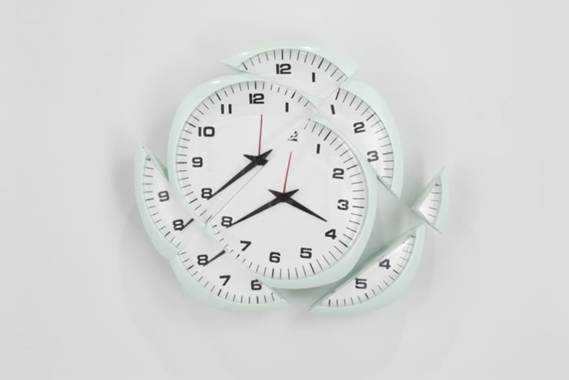Time Capsule #3 – Time (Story)
Richard Hughes, Untitled (Triptick), 2009, cast polyurethane, H. 12 1/2 x W. 14 x D. 2 1/2 in., Courtesy of the artist, Anton Kern Gallery, N.Y., and Hall Collection, © 2009 Richard Hughes, Anton Kern Gallery, N.Y., and Hall Collection; Photo: Thomas Müller
By Camille Tewell
March 7th, 2013. Fort Worth, TX: I am seated in a museum gallery with a bunch of museum educators from around the country. We have come together in this space for a single hour with a single purpose: to look at a work of art and talk about it.
We’ve done this before, and we’ll do it again, but each experience holds untold possibilities for pleasure and revelation. I can’t help but feel excited. I search the face of our facilitator—a master teacher—knowing that she isn’t here to tell me what I should know or think about this work of art and yet still feeling she is the gate-keeper to the discovery that is about to take place.
We quiet ourselves, get focused—and then somehow the discussion begins. I listen closely to the words of my peers as they begin to unpack this work of art. I am so alert, so mentally present—my brain is buzzing along the flow of discussion, almost too swiftly at times—I have to work to stay with it. Suddenly, I am on the edge of my seat, bolt upright, like a nervous spring. My breathing speeds up and my palms begin to sweat. An idea is pressing on me—I must speak! My hand flies into the air, and now my voice joins the music, and together we move through the work of art, at times swift, then slow, rising and falling with revisions and additions until at last coming to a rest. In the end not a thing has been decided, but nearly all of us are satisfied with the journey, the experience we’ve just had together with this work of art.
John Dewey described “an experience” as something that happens that is set off from the regular flow of time—something special, out of the norm, marked as different. During “an experience,” time may feel suspended (see also Csikszentmihalyi and the idea of “flow”). To become immersed in a work of art like this seems like the sort of thing Dewey was talking about.
Have you had “an experience” before? What were you doing when it happened? What was it about? Why was it important? How can we cultivate rich, memorable experiences for students?
A few years ago I took some TIME for myself—for my own professional development. I attended the Teaching Institute in Museum Education (TIME) at the School of the Art Institute of Chicago. There I learned the value of looking closely at and thinking deeply about works of art. I learned the value of listening to others and letting shared and divergent understandings emerge. I practiced slowness, careful investigation, and open-mindedness. Every now and again we “TIME-ers”—other museum educators who’ve attended TIME—reconvene to cultivate “an experience” with a new work of art and remember why we thought it valuable in the first place. This year we met in Fort Worth, TX, as part of the National Art Education Association Conference. Each time we meet I walk away changed, inspired, and renewed. Something wonderful seems to happen to my mind when I allow myself the time and space to become utterly absorbed.
You don’t need to be a “TIME-er” or a museum educator, for that matter, to recharge your store of Dewey experiences. You don’t need to go to Fort Worth or Chicago, either. The NCMA is a place where this sort of magic—suspended time and deep engagement—is possible, be it with art, ideas, and/or the natural world. Did you know that? Do your colleagues know it? Lose yourself in an exhibition, our Park, the permanent collection, or a workshop experience. Let us be your place of refuge—a place to take time for yourself and recharge your teaching practice. We’re here all summer.
This is the third and final installment of Timecapsules, a micro-post series on the Big Picture concept of Time. Don’t miss our special exhibition exploring this theme through a variety of media, 0 to 60: The Experience of Time through Contemporary Art, open now through August 11, 2013

